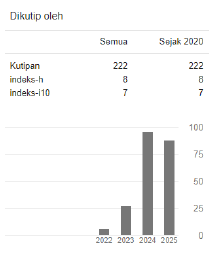The Effect of Talking Chips Technique on Speaking Ability of Class X Students of SMA Negeri 3 Bandar Lampung
 https://doi.org/10.54012/ijcer.v1i1.73
https://doi.org/10.54012/ijcer.v1i1.73
 Abstract views: 230
Abstract views: 230
 PDF downloads: 49
PDF downloads: 49
Keywords:
talking chips technique, speaking skill, drilling, learning processAbstract
Innovative teaching techniques such as talking chips have gained attention for their ability to actively enhance student participation in discussions. This technique encourages students to build confidence in expressing their ideas and interacting with classmates. The objective of this research is to identify and describe whether the talking chips technique influences students’ speaking abilities and to determine whether the average speaking scores of students taught using the talking chips technique are higher than those of students taught using the drilling technique. This study was conducted on Grade X students at SMA Negeri 3 Bandar Lampung. The researcher employed an experimental method, with the sample determined using the cluster random sampling technique, as the population was considered homogeneous. Two classes were selected out of ten as the research sample. Data were collected through speaking tests and analysed using the t-test formula. The findings of the study indicate a positive and significant influence of the talking chips technique on the speaking abilities of Grade X students at SMA Negeri 3 Bandar Lampung. Students taught speaking using the talking chips technique achieved higher scores compared to those taught using the drilling technique. This is evident from the hypothesis testing results and the higher average scores of the experimental class compared to the control class. The average score of the experimental class was 72.67, while the average score of the control class was 67. Moreover, at significance levels of 0.01 and 0.05, the t-test value exceeded the t-table value, specifically 2.87 > 2.66 for the 0.01 significance level and 2.87 > 2.00 for the 0.05 significance level.
Downloads
References
Mustikawati, A., “Pendekatan inovatif dalam pengajaran menulis,” Jurnal Pendidikan Bahasa, vol. 15, no. 2, pp. 112–125, 2018.
Hyland, K., Teaching and Researching Writing. London: Routledge, 2016.
Rahmat, A., and Anjani, S., “Kesulitan siswa dalam menulis teks recount di sekolah menengah,” Jurnal Penelitian Pendidikan, vol. 10, no. 3, pp. 201–214, 2020.
Storch, N., Collaborative Writing in L2 Classrooms. Bristol: Multilingual Matters, 2019.
Vygotsky, L. S., Mind in Society: The Development of Higher Psychological Processes. Cambridge, MA: Harvard Univ. Press, 2016.
Widyaningsih, R., and Rahmawati, D., “Peningkatan motivasi belajar menulis melalui pendekatan kolaboratif,” Jurnal Pendidikan Bahasa dan Sastra, vol. 18, no. 1, pp. 45–53, 2017.
Brown, H. D., Principles of Language Learning and Teaching, 6th ed. White Plains, NY: Pearson Education, 2018.
Suwandi, and Anjani, F., “Efektivitas collaborative writing dalam pembelajaran menulis teks deskriptif,” Jurnal Linguistik dan Sastra, vol. 14, no. 2, pp. 134–145, 2019.
Yendra, Pratial, “Sistem skoring komprehensif untuk evaluasi kemampuan menulis siswa,” Jurnal Penilaian Pendidikan, vol. 5, no. 2, pp. 88–98, 2017.
Anderson, L. W., and Krathwohl, D. R., A Taxonomy for Learning, Teaching, and Assessing: A Revision of Bloom's Taxonomy of Educational Objectives. New York: Longman, 2015.
Kementerian Pendidikan dan Kebudayaan Republik Indonesia, “Panduan Implementasi Kurikulum 2013,” 2019.
Cheng, G., et al., “Pengaruh collaborative writing terhadap kecemasan menulis siswa,” Asian Journal of Education, vol. 23, no. 4, pp. 215–227, 2020.
Zhang, H., and Zou, W., “Collaborative writing and its impact on reducing writing anxiety,” Journal of Language Education, vol. 28, no. 1, pp. 12–21, 2018.
Brown, J. D., “Pendekatan berbasis pengalaman dalam pembelajaran menulis,” International Journal of Language Teaching, vol. 6, no. 3, pp. 45–56, 2021.
Anderson, R. C., et al., “Collaborative writing dalam pengajaran teks recount,” Journal of Literacy Research, vol. 32, no. 2, pp. 89–102, 2022.
Suwandi, “Eksperimen pengajaran kolaboratif dalam pengajaran teks recount,” Indonesian Journal of English Teaching, vol. 10, no. 1, pp. 56–67, 2019.
Rahmat, A., et al., “Penggunaan pendekatan kolaboratif dalam pembelajaran bahasa,” Jurnal Pengajaran Bahasa dan Sastra, vol. 15, no. 4, pp. 143–155, 2020.
Hyland, K., Second Language Writing, 2nd ed. Cambridge: Cambridge Univ. Press, 2019.
Storch, N., “Collaborative writing as a pedagogical tool,” Language Teaching Research, vol. 24, no. 2, pp. 221–245, 2020.
Widyaningsih, R., “Pendekatan kontekstual dalam pengajaran teks recount,” Jurnal Pendidikan Bahasa, vol. 12, no. 3, pp. 98–112, 2021.
Downloads
Published
How to Cite
Issue
Section
License
Copyright (c) 2022 Adelina Anum

This work is licensed under a Creative Commons Attribution-ShareAlike 4.0 International License.









